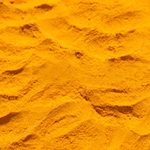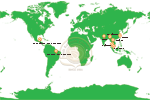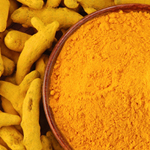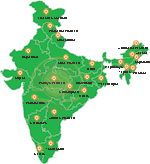
The Binomial name of Turmeric is Curcuma longa L – Linnaeus. Turmeric is an ancient spice, a native of South East Asia, used from antiquity as dye and a condiment. Its use, dates back nearly 4000 years, to the Vedic culture in India where it was used as a culinary spice and had religious significance. Turmeric is a preservative. Its active ingredient is Curcumin and it has an earthy, bitter, peppery flavor.
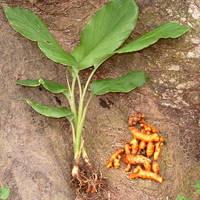 |
Turmeric is sharp and earthy in flavor, with just a hint of ginger, Turmeric complements any kind of rice, lentil, or vegetable dishes. It should, however, be used sparingly. While Turmeric tastes pleasantly spicy, a little goes a long way and it gets stronger as it cooks.·Turmeric can be cultivated organically as an intercrop along with other crops provided that all the companion crops are also organically grown. In some areas, Turmeric is grown as an intercrop with mango, jackfruit and litchi and on the west coast with coconut and arecanut. Turmeric has been used to treat a variety of ailments.·Taken internally, Turmeric is used to treat headaches, diarrhea, flatulence, colds and fevers, edema, bronchitis, leprosy,
|
colic, kidney inflammation and cystitis. Practitioners of Ayurvedic medicine advocate Turmeric as a means of curing or relieving general inflammation, conjunctivitis, itching and skin ulcers, colic, constipation, flatulence, and parasites such as ringworms. Also used to treat Alzheimers , as an Anti-Inflammatory,in Arthritis, Atherosclerosis, Cancer ,Cataracts,, Cholesterol, Crohns Disease, Cystic Fibrosis, Liver Disease, etc.
ately 75-80%.Also India consumes around 80% of its own production.
The exact origin of Turmeric is unidentified but it is said that it originated in the parts of western India. It has been used in India for 5000 years now. Initially it was cultivated as a dye as its bright yellow color works as a coloring agent. Then with time people came to know about its developed uses and they started using it for cosmetic purposes and then as a medicine. Turmeric reached China by 700AD, East Africa by 800AD and West Africa by 1200AD and started becoming popular through out the world.The Arab traders took turmeric to Europe in 13th century. Marco Polo was so impressed by turmeric that he mentioned it as a vegetable that has properties of saffron, but it is not really saffron. Ancient Indian medical literature, Ayurveda also mentions about turmeric being an extremely effective herb for stomach disorders and food poisoning.
Turmeric is a 5000 years old herb, that belongs to, Zingiberaceae,the family of Ginger. Its rootstalk, in powdered form, is used as a spice (also a dye) throughout the world. This tropical herb plant is usually 3 to 5 feet in height having flowers of dull yellow color and is largely cultivated in the parts of Southeast Asia. Turmeric as spice is deep yellow in color having a pungent flavor. To convert it into a powdered form, the rootstalk is boiled, dried, cleaned and polished and then powdered.
turmeric is produced annually, of which 92-95% is consumed within the country and remaining 5-8% is exported yielding foreign exchange ranging from 40 to 110 million rupees annually.
Here are 20 reasons to add turmeric to your diet:
|


